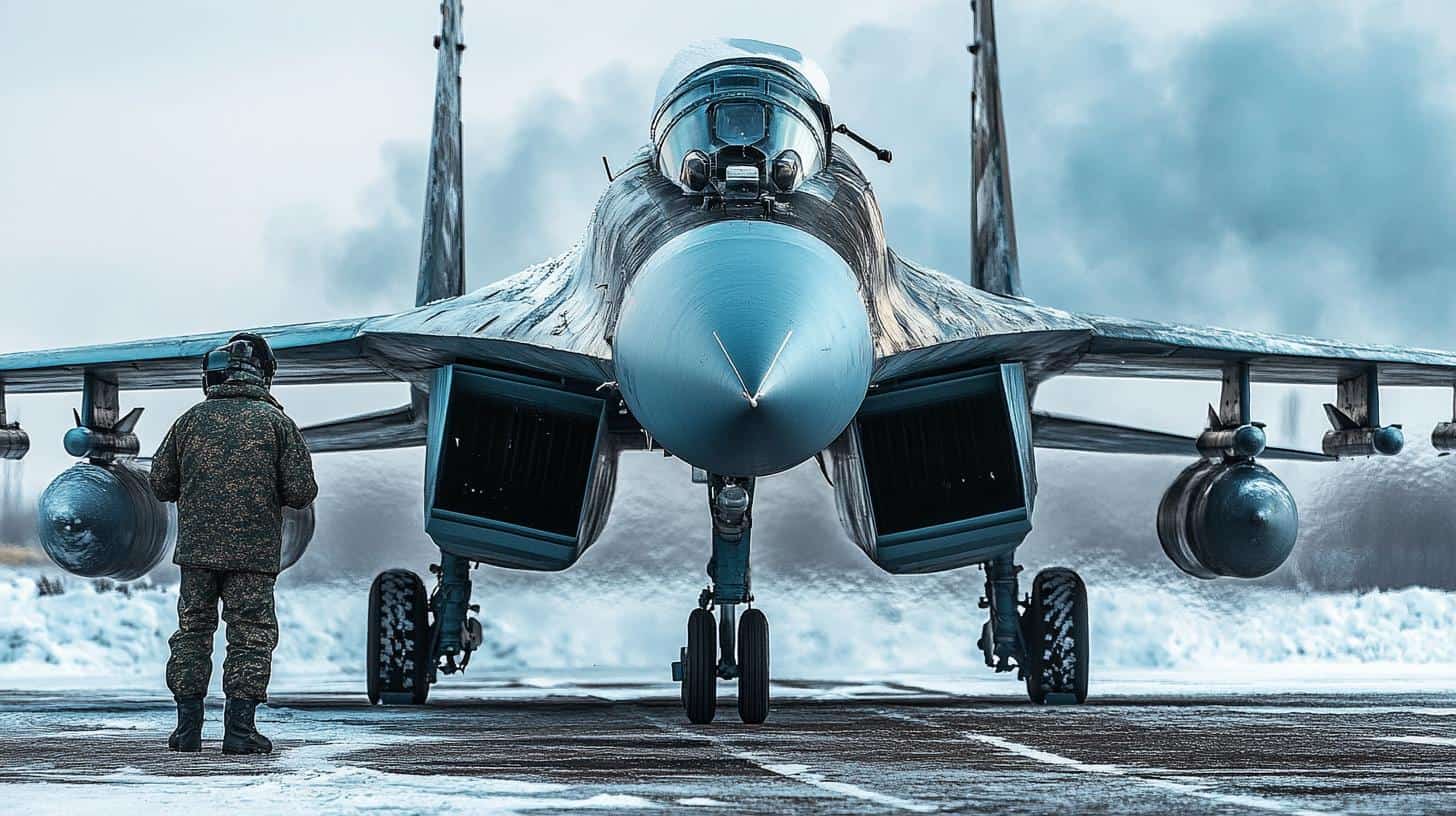The ongoing conflict between Ukraine and Russia has highlighted the critical role of advanced air defense systems, particularly the effectiveness of Ukrainian F-16s against Russian Su-34 fighter-bombers. Recently, a prominent Russian commentator indicated that a Ukrainian F-16 successfully shot down one of these aircraft, shedding light on the changing dynamics of aerial engagement in this war.
Ukrainian military assets have substantially increased their operational capabilities, with a combination of ground-based air defense and the advanced maneuverability of F-16s presenting a serious threat to Russian air operations. Reports suggest that several Su-34s have been downed by Ukrainian missile defense systems, which include the National Advanced Surface-to-Air Missile Systems (NASAMS) and U.S. provided Patriot batteries. This indicates a critical vulnerability in the larger, less agile Su-34 bombers, which, despite their substantial weaponry capacity, have proven to be less resilient in combat.
Ukrainian military officials have confirmed the surprising success of the Patriot system against aircraft, even though it was originally designed primarily for intercepting ballistic missiles. These developments underscore the adaptability and evolution of missile defense technologies, as recent upgrades allow the Patriot missiles to target maneuvering aircraft effectively.
As the conflict progresses, the inability of the Russian Air Force to establish air superiority, despite their numerical advantage, is becoming increasingly apparent. The ongoing effectiveness of Ukrainian air defenses heralds a significant shift in the aerial tactics employed by both sides.
The Impact of Advanced Air Defense Systems in Modern Warfare
The ongoing conflict in Ukraine has not only altered the geopolitical landscape but also transformed the way nations approach military strategy, particularly concerning air defense systems. As nations around the world witness the effectiveness of advanced air defense technology, the implications for people, communities, and even entire countries are profound.
The use of advanced air defense systems has significantly impacted civilian safety in conflict zones. With the capability to intercept incoming aerial threats, these systems provide populations with a greater sense of security. In Ukraine, the deployment of systems like the Patriot missile defense has proven crucial in protecting urban centers from aerial bombardment, potentially saving countless lives. A notable instance occurred when reports emerged that a Ukrainian F-16 successfully shot down a Russian Su-34, showcasing the effectiveness of these advanced technologies in neutralizing threats before they could reach civilian areas.
However, the reliance on advanced weaponry has raised some controversies. Critics argue that the arms race triggered by the conflict may lead to an escalation of hostilities, further endangering innocent lives. The influx of military assets into the region prompts discussions about ethical responsibilities and the potential for increased collateral damage amid ongoing military operations.
The implications of air defense systems also extend beyond immediate military engagements. Countries observing the struggle in Ukraine are reconsidering their defense strategies. Many nations are now investing more heavily in air defense technologies, leading to an accelerated arms race. For instance, NATO member states are revisiting their military budgets, allocating significant funds towards modernizing their air defense capabilities. This shift has created opportunities for defense contractors and has sparked debates over national security versus economic growth.
Interestingly, the technological advances in missile defense systems also open new avenues for international collaboration. Countries like the United States, Ukraine, and Poland have been enhancing their cooperative defense initiatives, sharing technologies and best practices. This collaboration not only strengthens military alliances but can also foster advancements in peaceful applications of technology, such as surveillance and disaster response mechanisms.
Moreover, the situation in Ukraine serves as a crucial case study for military and political analysts worldwide. It elucidates the evolving nature of warfare, where traditional strategies must adapt to face new challenges posed by advanced technology. The conflict has emphasized the critical need for rapid innovation in military tactics and technologies and has forced nations to rethink their preparedness for aerial threats.
The controversy surrounding air defense systems is not limited to military doctrine; it also permeates diplomatic relations. Countries that supply advanced military systems may face backlash regarding their role in the conflict, thus impacting their international standing. The moral implications of providing such weaponry continue to be debated—are these countries protecting democracy or fueling an ongoing war?
As air defense matters gain traction in global discourses, every aerial conflict from Ukraine to the Middle East influences public sentiment and government policies. The duality of peace and war, safety and risk, continues to shape the lives of everyday citizens caught in these geopolitical struggles.
For more insights on military technology and its implications, visit Defense News.
The article has been updated: 2024-11-02 12:40
Here are some suggested related links for your post title “Ukrainian Forces Leverage Advanced Systems Against Russian Su-34s”:
1. Defense.gov – The official website of the U.S. Department of Defense, providing news and information on military operations, strategies, and technologies relevant to ongoing conflicts, including insights on advanced weapon systems.
2. BBC News – A leading global news organization offering comprehensive coverage of the Ukraine conflict, including articles on military developments and international responses to the war.
3. The Guardian – A prominent news outlet that covers international affairs and military news, offering in-depth analysis and reports on the situation in Ukraine and Russia.
4. Reuters – A reputable news agency that provides updates and analysis on global news, including the latest reports on military engagements and defense capabilities in the Ukrainian conflict.
5. Military.com – A site dedicated to military news and resources, offering articles about advanced military technologies and their applications in current conflicts, including the use of advanced systems in Ukraine.
6. Janes – A trusted source for defense and security intelligence, providing detailed information on military technology and systems, including the analysis of the Su-34 and other aircraft used in Ukraine.
7. The Washington Post – A major American newspaper providing coverage of the Ukraine conflict, military strategies, and insights into the technology used by Ukrainian forces.
8. France 24 – An international news channel that provides updates and analysis on global events, including the situation in Ukraine and the military developments involving Russian and Ukrainian forces.
9. Army Times – A news source focused on U.S. Army and military news, covering stories related to advanced military systems and their deployment in various conflict zones, including Ukraine.
10. CNN – A leading news organization with extensive coverage of international news, including real-time updates and analyses of the Russia-Ukraine war and the technology used by both sides.
These links provide a diverse range of insights and news related to the ongoing conflict and the use of military technology.
The article has been updated: 2024-11-03 21:18
How are Ukrainian forces effectively using advanced systems to counter Russian Su-34s?
Ukrainian forces have been leveraging advanced air defense systems and weaponry to effectively counter the threat posed by Russian Su-34 fighter-bombers. These systems include both domestically developed technologies and foreign-supplied equipment, which enhance their capability to detect, track, and engage enemy aircraft. For instance, the integration of advanced radar systems allows Ukrainian forces to identify and target Russian aircraft at greater distances, while modern missile systems provide them with the firepower necessary to intercept and neutralize threats. This strategic utilization of technology not only increases the survival rate of Ukrainian ground forces but also disrupts Russian air operations in the region.






















